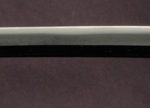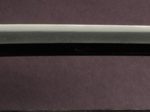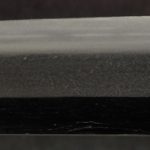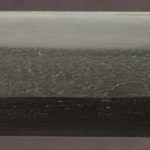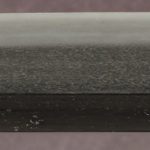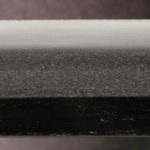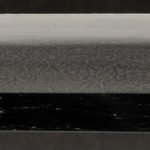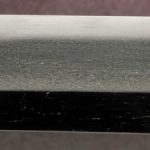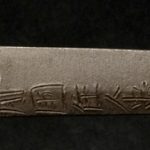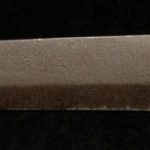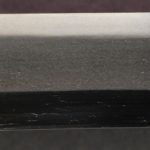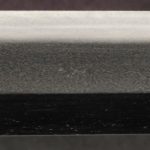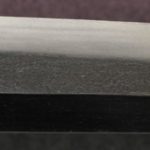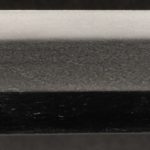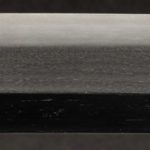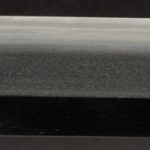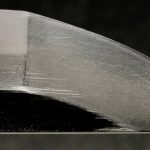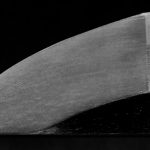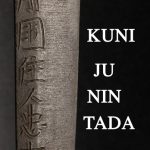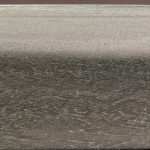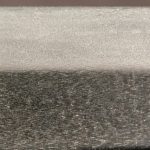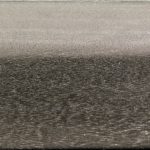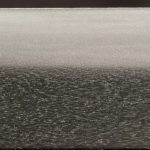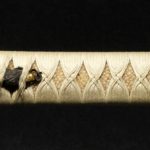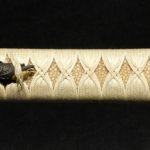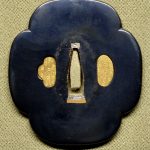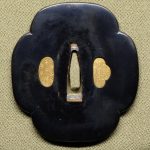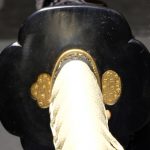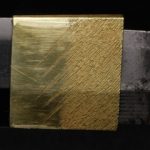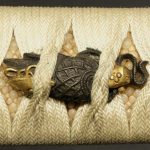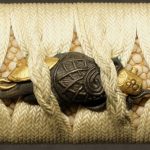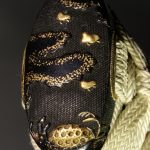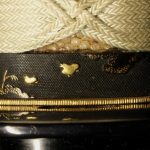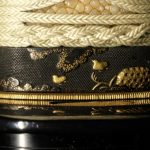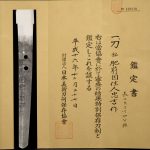TADAYOSHI / HIZEN / SHODAI / NLA
TADAYOSHI, HIZEN
SHODAI (1st Generation)
NBTHK TOKUBETSU HOZON
KUBIKIRI ASAEMON RATED (Sharpness): SAIJO O WAZAMONO
FUJISHIRO’S RATED (Quality): SAIJO SAKU
MEI: HIZEN no KUNI JUNIN TADAYOSHI SAKU
DATE: NONE
NAGASA: 70.80cm (27.875″)
OVERALL: 92.07cm (36.25″)
MIHABA: 3.175cm (1.25″)
KASANE: 0.6794cm (0.3125″)
SORI: 1.587cm (0.625″)
NAKAGO: UBU
MEKUGI ANA: TWO (ONE FILLED)
YASURIME: KIRI
MUNE: IORI
HADA: KONUKA
HAMON: SUGUBA
BOSHI: KO-MARU
HORIMONO OMOTE: NONE
HORIMONO URA: NONE
HABAKI: 1 PIECE GOLD FOIL
SHIRASAYA & KOSHIRAE
NBTHK TOKUBETSU HOZON
A bit of Tadayoshi history from Sesko’s, Swordsmiths A-Z:
TADAYOSHI (忠吉), 1st gen., Keichō (慶長, 1596-1615), Hizen –
“Tadayoshi” (忠吉), “Hizen Tadayoshi” (肥前忠吉), “Tadayoshi saku”
(忠吉作), “Hizen no Kuni Tadayoshi” (肥前国忠吉), “Hizen no Kuni-jūnin
Tadayoshi” (肥前国住人忠吉), “Hizen no Kuni-jū Hashimoto Shinzaemon
no Jō Tadayoshi saku” (肥前国住橋本新左衛門尉 忠吉作), “Hizen no Kuni
Saga-jū Hashimoto Shinzaemon no Jō Tadayoshi saku” (肥前国佐賀住橋本
新左衛門尉忠吉作), “Hizen no Kuni-jūnin Minamoto Tadayoshi” (肥前国
住人源忠吉), “Hishū-jū Tadayoshi kono Tadayoshi Umetada Myōju deshi”
(肥州住忠吉此忠吉埋忠明寿弟子), for the signature variants of the name Tadahiro see entry “TADAHIRO (忠広), 1st gen., Kan ́ei (寛永, 1624-1644), Hizen,” real name Hashimoto Shinzaemon (橋本新左衛門). He was born in the third year of Genki (元亀, 1572), the son of the Tenshō-era (天正, 1573-1592) smith Hashimoto Michihiro (橋本道弘) from Nagase (長瀬) in the Saga district (佐賀郡) of Hizen province. In Nagase, a small group of swordsmiths had been active since the late Muromachi period and some of them even signed with the name Tadayoshi (忠吉). For example we know a hira-zukuri ko-wakizashi with the mei “Hizen no Kuni-jū Tadayoshi” (肥前国住忠吉) which is dated Daiei five (大永, 1525). But it is unclear if this early Tadayoshi is connected with the later Tadayoshi at all. Well, this Tadayoshi was employed by Nabeshima Naoshige (鍋島直茂, 1538-1618), the first daimyō of the Saga fief (佐賀藩, 357.000 koku) for a salary of 25 koku. Naoshige sent him in the first year of Keichō (慶長, 1596) to Kyōto to study under master Umetada Myōju (埋忠明寿). Tadayoshi returned to Saga in Keichō three (1598) and moved thereupon from Nagase to the castle town of Saga. He received his honorary title Musashi no Daijō (武蔵大掾) on the 18th day of the second month of Genna ten (元和, 1624) and changed his smith name in this course to Tadahiro (忠広). That means Hashimoto Shinzaemon was the 1st generation Tadayoshi and the 1st generation Tadahiro. From him we know dated blades from the first year of Keichō (1596) to the ninth year of Kan ́ei (寛永, 1632). He died on the 15th day of the eighth month of Kan ́ei nine (1632) at the age of 61. In his early years he made blades with a noticeable Keichō-shintō-sugata. The jihada is clearly visible, somewhat loose and stands out. Regarding the hamon, he tried to copy famous models and made quite close Aoe (青江), Chōgi (長義) and Shizu-utsushi (志津). From around Keichō ten (1605) his ji-nie and chikei are more evenly distributed and the typical Hizen konuka-hada appears. The hamon then becomes a nie-laden suguha in ko-nie-deki with wide nioiguchi, a notare or also a gunome-chōji-midare. The perfect and very uniform suguha appears only in his later years. Works in shallow notare also show kuichigaiba and/or nijūba. At the beginning of his career he signed with a rather small and compact goji-mei of the kind “Hizen no Kuni Tadayoshi” whereas it is said that the style goes back to the priest Shūgan (秀岸) who taught him in calligraphy. Accordingly, this kind of mei is also called Shūgan-mei (秀岸銘), or sometimes also yamabushi-mei (山伏銘). Blades which show the supplement jūnin in the signature are called jūnin-mei (住人銘). Tadayoshi always signed long swords with a tachi-mei and wakizashi and tantō with a katana-mei. After receiving the title Musashi no Daijō he also hardened an ō-midare or ō-chōji-midare or rarer hamon variants like a chōji-midare with conspicuously long ashi or a notare mixed with gunome-chōji pairs with rather angular yakigashira. In the case of a midareba, plenty of sunagashi along the tani of the yakiba is always seen. The bōshi mostly shows a uniform width and runs parallel along the fukura to a ko-maru-kaeri. Engravings were often done by local horimono masters like Munenaga (宗長), Yoshinaga (吉長) or Tadanaga (忠長). In general, it can be said that Tadayoshi ́s jiba is very bright and clear and his blades were known for their superior sharpness, saijō-ō-wazamono, saijō-saku.
A gorgeous Katana by the shodai or first generation Hizen Tadayoshi. This sword was awarded Tokubetsu Hozon by the NBTHK in 2004. It is flawless and a beauty to behold. The nakago is ubu though there are two mekugi ana, one being filled. The Hada is Konuka or rice bran as is typical for the smith and school. By 1605 the Konuka hada was well developed. This mei was used between 1615 and 1624 and looking closely at the mei it shows the changes in the strokes which were made in 1619. This kantei points indicate this sword was made between 1619 – 1624. The Hamon is suguba with a very fine ko-nie sprinkled throughout. The habaki is a one piece, gold foiled with a rain pattern.
The koshirae is very elegant and formal with the white string wrap and black lacquered saya. The Fuchi/ Kashira are shakudo with nanako and depict a sea or river side fishing scene. There is water, a fish trap and plovers flying nearby. The menuki are travelers gear as a bundle with Daikoku’s hammer, a rain shroud, hat and a coil of rope. The Tsuba is simple yet elegant done in rich black shakudo. The hitsu ana have been filled with gold plugs.
This sword comes with NBTHK Tokubetsu Hozon papers, Koshirae, and Shirasaya.
Price: No Longer Available
- There is a three (3) day inspection period for this sword. If for any reason you are dissatisfied you may return it for a full refund minus all fees related to its return. This includes but is not limited too, shipping, insurance, wire transfers etc.
If you are interested in owning this item, contact me directly at yakiba.com@gmail.com
